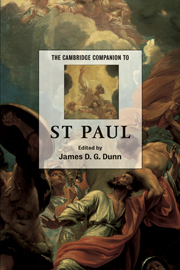Book contents
- Frontmatter
- Introduction
- Part I Paul’s life and work
- Part II Paul’s letters
- 3 1 and 2 Thessalonians
- 4 Galatians
- 5 1 and 2 Corinthians
- 6 Romans
- 7 Philippians
- 8 Colossians and Philemon
- 9 Ephesians
- 10 The Pastoral Epistles
- Part III Paul’s theology
- Part IV St Paul
- Select bibliography
- Index of References
- General Index
6 - Romans
from Part II - Paul’s letters
Published online by Cambridge University Press: 28 May 2006
- Frontmatter
- Introduction
- Part I Paul’s life and work
- Part II Paul’s letters
- 3 1 and 2 Thessalonians
- 4 Galatians
- 5 1 and 2 Corinthians
- 6 Romans
- 7 Philippians
- 8 Colossians and Philemon
- 9 Ephesians
- 10 The Pastoral Epistles
- Part III Paul’s theology
- Part IV St Paul
- Select bibliography
- Index of References
- General Index
Summary
The longest and most influential of Paul's letters has a complex textual history, with fourteen families of texts featuring varied arrangements of the final chapters. While many earlier scholars tended to view chapter 16 as not originally intended for Rome, recent studies have demonstrated that the original version of the letter contained the material of all sixteen chapters. It is likely, but far from generally accepted, that 16:17-20 and 16:25-57 are interpolations reflecting later interpretations of the letter.
Romans is carefully organized, with an introduction in 1:1–15, a thesis statement in 1:16–17, four proofs (1:18–4:25; 5:1–8:39; 9:1–11:36; and 12:1–15:13), and an elaborate conclusion in 15:14–16:24. From the perspective of classical rhetoric, Romans is an ‘ambassadorial’ message in the demonstrative genre that seeks to encourage a particular ethos in the audience so they will support a project that Paul has in mind. The introduction and conclusion indicate that the primary purpose of the original letter was to elicit support for Paul’s mission to Spain, mentioned in 15:24, 28. Since there was no significant Jewish population in Spain at this time, which eliminated the possibility of starting a mission in the usual manner in a Jewish synagogue, advance preparations were required.
- Type
- Chapter
- Information
- The Cambridge Companion to St Paul , pp. 91 - 104Publisher: Cambridge University PressPrint publication year: 2003
- 2
- Cited by

